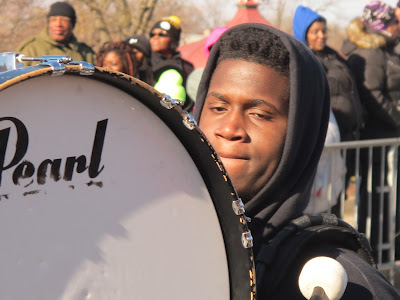The parade begins at the intersection of Martin Luther King, Jr. Boulevard and Eutaw Street near State Center and proceeds south on Martin Luther King Jr. Boulevard to Baltimore Street. Spectators are invited to view the parade from along the route or near the reviewing stand at Martin Luther King, Jr. Boulevard and Franklin Street. That make it not only a short parade but also one that happens only on one half of the divided highway named after civil rights leader with cars, trucks and buses roaring up the northbound side separated from the parade only by a median.
 |
| Drumming for equal rights and justice |
So it is not only the usually frigid January temperature that puts spectators and participants into a rather uncomfortable position. Chilling is also the fact that the route can only on one side be safely lined by cheering crowds and that the stage is positioned awkwardly on a major intersection with a freeway overpass casting its shadows and providing another set of roaring vehicles.
Baltimore's Martin Luther King is neither a real boulevard nor it is a historic street. It defies the historic street-grid and has been blasted as an arc into the urban grid fabric as part of urban renewal that brought also the string of public housing projects of Lexington Terrace, Murphy Homes and McCulloh Homes as well as the State Center office complex. The thus created roadway is the western part of a somewhat disjointed and incomplete ring-road that serves as a bypass around downtown (the eastern part is President Street, the southern is Pratt Street and the northern is Mt Royal Avenue). In many ways MLK also acts as a moat around downtown that is both a visual and a physical barrier for pedestrians that want to move back and forth across the divider.
 |
| This is not an urban boulevard! (ArchPlan) |
It is not my place to suggest alternative parade routes, yet it is tempting to imagine the parade beginning at Penn and North winding down to Franklin with a terminus at the Lexington Market with the food vendors selling hot soup at stalls temporarily erected on that surface parking lot next to the market. For all its disinvestment and disrepair, Penn Ave would be a real street with a great history very well suited to the legacy of Dr. King. That would also work well with the idea of the Innovation Village announced today.
As far as Martin Luther King Boulevard, it is time to reduce its disruptive impact and tame it as a truly urban boulevard.
Klaus Philipsen, FAIA
See my article about urban repair at the former Social Security offices at MLK and Mulberry/Franklin
See my article about urban repair at the former Social Security offices at MLK and Mulberry/Franklin
Innovation Village: Partnership aims to revitalize Central West Baltimore
http://bsun.md/1Ss6wMR
All pictures of the 2016 parade ArchPlan:
 |
 |
| Add caption |
 |
| The Mayor out on foot |
 |
| Add caption |
 |
| Add caption |
 |
| Add caption |
 |
| A sketch of urban infill that could help to make MLK a real urban boulevard (graphic: ArchPlan) |

No comments:
Post a Comment